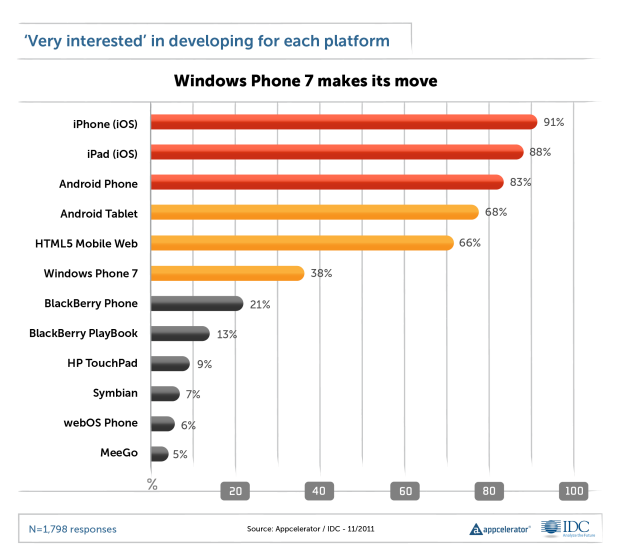Windows Phone, Kindle Fire make big gains among mobile app developers

Microsoft's massive investments in the Windows Phone platform have gotten the attention of the developer community, according to a new survey from Appcelerator/IDC. The other big winner in the battle for developer mindshare is a product that hasn't been released yet: Amazon's Kindle Fire.
The successful release of the Mango update for Windows Phone and the public announcement of the first wave of devices from the Microsoft/Nokia partnership have vaulted the Windows Phone platform into a clear #3 position among app developers, displacing the hapless BlackBerry platform.
Apple and Android maintain their dominant positions at the top of the mobile phone food chain. Here are some highlights from the survey:
- "iOS continues to reign at number one in developer interest levels with 91% of respondents saying they are ‘very interested’ in developing for the iPhone, followed by the iPad at 88%.
- "Android phones fell nearly 4 points to 83% while tablets fell nearly 6 points to 68%."
- "Windows Phone 7 separated from the pack to become the clear number three mobile platform this quarter. The OS climbed 8 points to 38% of respondents saying they are ‘very interested’ in the platform, the highest ever for Microsoft."
- "This quarter saw a sharp fall-off in developers reporting that they are ‘very interested’ in RIM offerings with BlackBerry OS phones dropping 7 points to 21% and PlayBook QNX-based tablets dropping 6 points to 13%."
Amazon also looks to have a hit on its hands with the new Kindle Fire, which has a chance to break away from a crowded field of Android tablets. According the survey, 49% of North American developers are "very interested" in the developing apps for the Kindle Fire, "just 4 points less than interest in the iPad (53%) prior to its launch in April 2010."
This chart shows how clearly Windows Phone has separated itself from the rest of the pack in the latest survey:
Chart credit: Appcelerator/IDC
Why the big move? Developers' motives varied depending on region. In Europe and Asia, the Nokia/Microsoft partnership was the top reason. In North America, 31% of respondents cited "upcoming Windows 8 integration / tablet potential" as the biggest draw.
And HTML5 continues to attract developer support, according to the survey, with 66% of developers "very interested" in building HTML5 mobile websites that will (in theory) work on any modern mobile device. That number is unchanged from last quarter.
The challenge for both Microsoft and Amazon is to translate that developer interest into increased sales and share. For Amazon, the proof could come this week, when customers get their hands on the new Kindle Fire. For Microsoft, actual increases in market share for phones will take longer, as devices roll out slowly worldwide. And its position in tablets is still nearly a year away, dependent on Windows 8.
Related posts:
- Nokia chief outlines Windows Phone strategy; warns of Android 'uncertainty'
- Kindle Fire besting Nook Tablet with more third-party partners
- Amazon's Kindle Fire economics: A focus on lifetime value of customer
- Microsoft launches several new 'Mango' phones but still no word on Verizon's next moves
- Nokia's Lumia Windows Phone moment of truth: Will consumers 'have to have them?'
